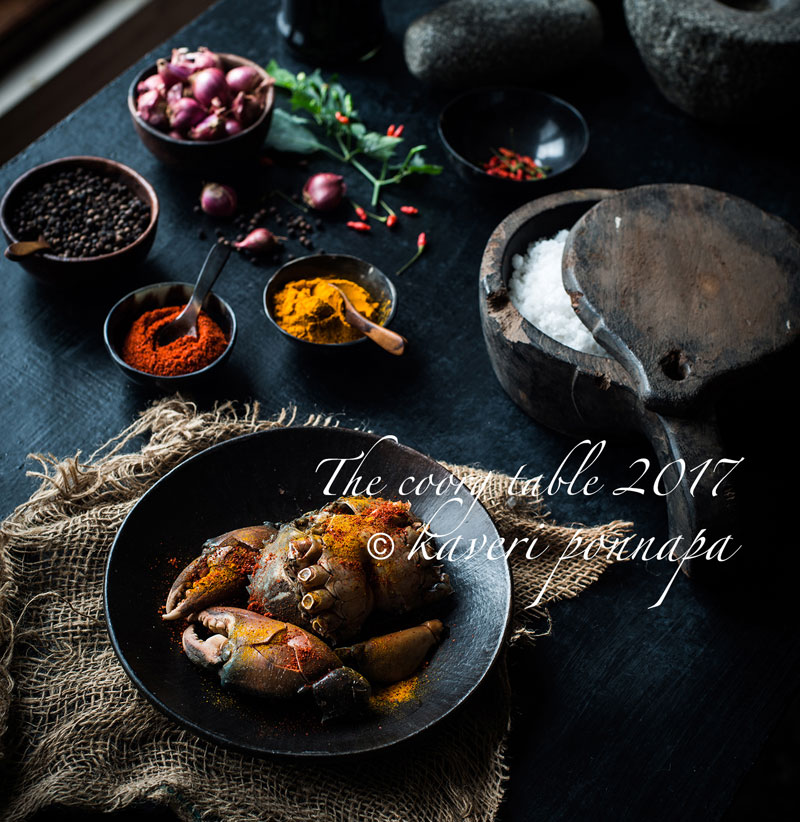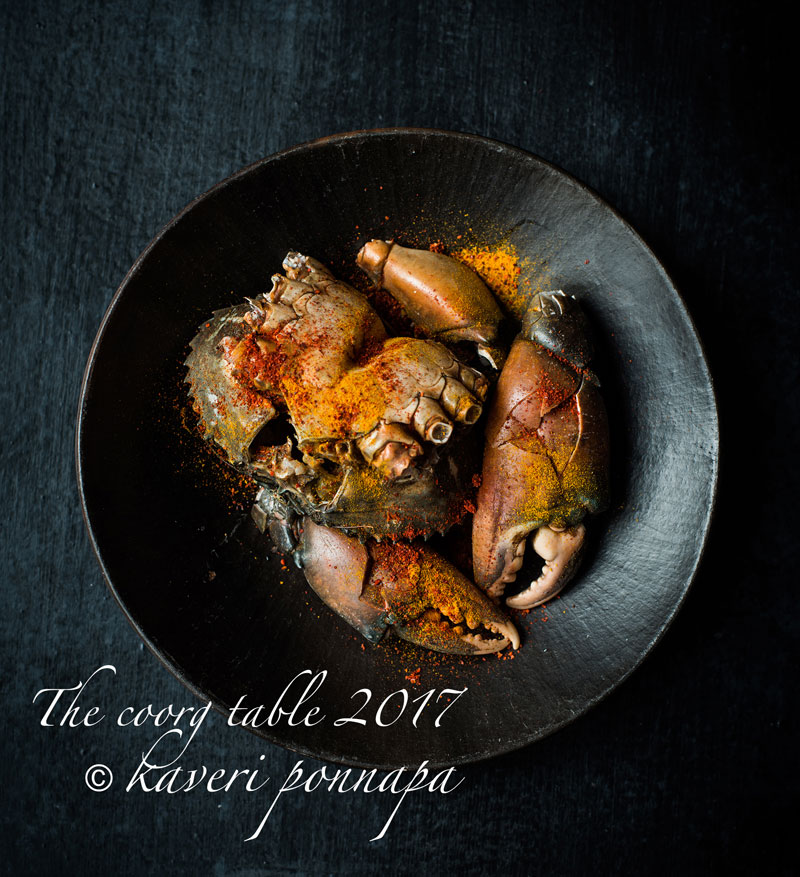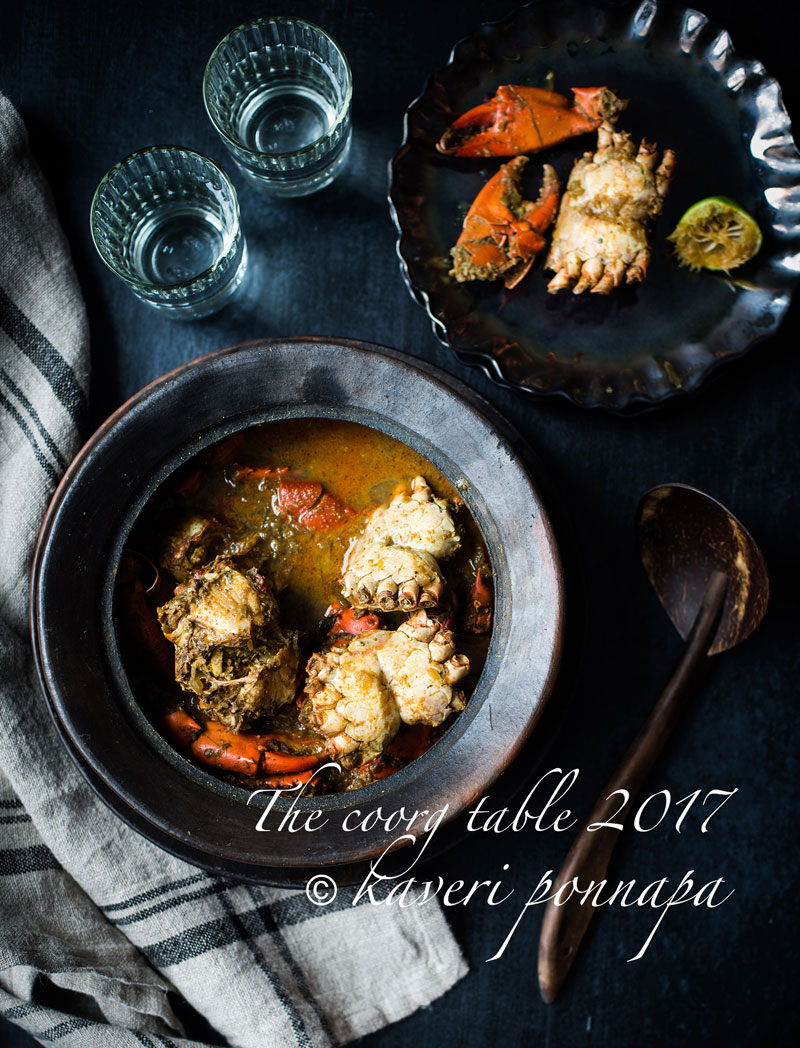We cluster together in a family kitchen, three women of different generations, bound by friendship, and a love for our food heritage. By all rights the room should have been dark from low-hanging clouds, and damp with moisture -instead, the sunlight streams in, hot and relentless and scarlet ixoras sparkle outside the window. There has been rain, enough to make dark, deep stains on the mud embankment beside the house and paint surfaces with bright green carpets of incredibly beautiful, microscopic moss. Maybe this is just a break, the rain will come back, we reassure ourselves; then the conversation veers towards food again. This is the time of year when the rain soaks the earth and stirs a whole, different, cherished micro-cuisine to life, short lived, much loved. Wild mushrooms, Hitchhiker Elephant Ear, tender bamboo shoots, Justicia wynaadensis, the medicinal leaf, and mud crabs –the secret language of monsoon cooking is learned and passed on from one generation to the next in this pocket of time. The fragrance of forest mushrooms fills the air as we prepare them for pickling, and someone is talking about mud crabs: about how they used to wrap chicken entrails around a stick, and entice them out of the ground, into the cooking pot. The pleasures of gathering and cooking foods that flourish briefly, close at hand, is not easily described.
Mud crabs are particularly prized at ‘kakkada’, a time of year when the monsoon beats down in all its fury; they are referred to, quite simply, as ‘kakkada njende’, crabs of the season. There are little nuances in how they are cooked, subtle differences that make each preparation a separate treat: the smallest ones roasted in mud pots, curry chatties, pounded into a chutney and then rubbed with spices and lime; the more robust ones are tossed directly onto the embers of a wood fire to be deliciously barbecued and seasoned. There’s a deep, spicy curry too, made to be soaked up with akki ottis.

But unique to the season is a rich, nourishing broth, minimally spiced, filled with flavour, perfect for the cold, wet days that not too many people remember now. It was simmered and served at a single sitting, never carried over to the next meal. I heard of it from a young friend who had last eaten it as a child, and had never forgotten the taste and textures. With this little scrap of taste memory began a hunt for this dish, And innumerable queries later, it ended with a brief but direct and satisfying description of how to make it.

On the narrow mud embankments that divide waterlogged rice fields, where newly planted seedlings have just begun to flourish, showing tender green, there are discreet burrows and small caverns that you might miss if you were not born and bred in the local countryside. Then there are the soggy stretches of land that border small, freshwater streams where, if you wade through a thick, flourishing forest of colocasia, you will see them again. This is where sweet-fleshed, soft-shelled mud crabs make their homes in the damp earth. A long time ago, my mother-in-law tried to tutor me in the art of trapping mud crabs with my bare hands. Game for most culinary adventures, this particular lesson remained a theory forever, never to be put into practice –the thought of those nimble, waving pincers and claws was far too intimidating, and I was happy to just cook and eat them. Crab hunting certainly sorts the women from the girls.
Aslesha Madappa is a statuesque Coorg beauty who cannot forget her first crab hunt. In her grandfather’s sprawling old home, childhood summer holidays were a jumble of days spent swimming in ponds, climbing trees and tagging along with her father when he went out to shoot fish. “One day”, she remembers, “my brother and I were left in the care of an older cousin, quite a hero to us all. The adults were out, and our grandfather was busy, so my cousin decided it was the perfect time to teach us city folks how to trap mud crabs.” Armed with sticks and a large vessel, they ran excitedly to the stream that flowed behind the house. The land was marshy, covered with a thick growth of colocasia. “We searched for crab-holes and, instructed by my cousin, we poked sticks into them. According to him, they were crab homes, but for all we knew, they could have been home to snakes and rats too!” The soil was soft and wet, sticks were dug deep into it, and then everyone waited. In a while, the mud crabs emerged. “My brother and I were too afraid to catch them, but our cousin collected them quickly in the empty vessel. He washed them, and rubbed them with salt and chilli powder procured from the kitchen. There was a wood fire built up outdoors that heated the bathwater. He threw the crabs in, turned them around a couple of times and then announced that they were done. He squeezed fresh lime juice over them and we ate them. Barbequed crabs have never tasted better.”

These are the tastes we remember and long for, the tastes that come with the seasons, the ones we go in search of, and bring back to our kitchens. We know that we need to make the most of it while the rains last: make the most of that edge of wildness that comes into the food we eat; the unpredictability; the intensity of the flavours that can never be reproduced in another place, in another season, no matter how hard we try. Such a brief season -but so lasting the concentration of flavours that link us, in a most elemental way, to our past.




It was fun sharing Asha’ s childhood experience. Hunting crabs.wish others could also share their memories.
Hello Carrol, thank you for visiting this page, I’m glad you enjoyed reading this post. Yes, it would be lovely to have more people share their food memories. Best wishes. Kaveri
Radhika, That brought back wonderful memories of our summer holiday in Coorg, when each day was an adventure.
Love the way you curate recipes and ably supported with superb photographs!!
Those containers and vessels from Coorg, so traditional and authentic! Madappa specially liked the salt container.
The other day my cousin brought cooked field (mud) crabs with soft shell, cooked so well, for my Mum, it was yummy. I must admit, the “child” in me surfaces very often with all these.
Hi Asha, I am delighted that you enjoyed this post -thank YOU for being part of the story, and for having so generously shared your memories with me. The curry is just stunning, a recipe to keep. The vessels do add a certain warmth to the posts, and end up being used in the kitchen too.It has taken a lot of searching and time to locate the old vessels, but it was worth the effort. I’m happy that the salt container brought back memories. Enjoy your mud crab curry, and do keep reading! Warm wishes.
Even I do remember we cousins used to go to catch the crabs near streams, paddy fields and also seen making curry and pajjis of these crabs. Nice memories…. Your vessel collections are very nice….Nice writing with wonderful photos…
Hi Kaverappa, welcome back! I’m glad that you liked the post. The vessels are beautiful, although they are a little more difficult to maintain, I still love them, and love to cook in them. There’s nothing like a curry chatti to add its own, unique flavour to the food. Do keep reading! Warm wishes.Kaveri